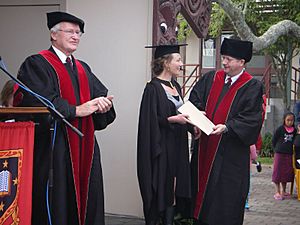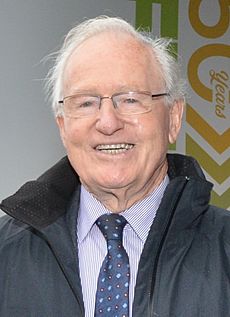Jim Bolger facts for kids
Quick facts for kids
Jim Bolger
|
|
|---|---|
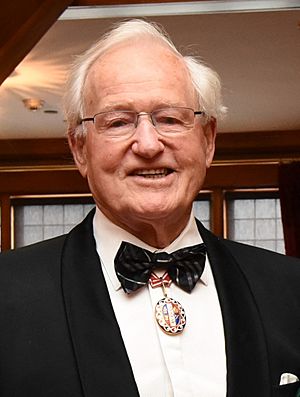
Bolger in 2018
|
|
| 35th Prime Minister of New Zealand | |
| In office 2 November 1990 – 8 December 1997 |
|
| Monarch | Elizabeth II |
| Deputy | |
| Governor-General | |
| Preceded by | Mike Moore |
| Succeeded by | Jenny Shipley |
| 7th Leader of the National Party | |
| In office 26 March 1986 – 8 December 1997 |
|
| Deputy |
|
| Preceded by | Jim McLay |
| Succeeded by | Jenny Shipley |
| 25th Leader of the Opposition | |
| In office 26 March 1986 – 2 November 1990 |
|
| Prime Minister |
|
| Deputy |
|
| Preceded by | Jim McLay |
| Succeeded by | Mike Moore |
| 27th Minister of Labour | |
| In office 13 December 1978 – 26 July 1984 |
|
| Prime Minister | Robert Muldoon |
| Preceded by | Peter Gordon |
| Succeeded by | Stan Rodger |
| 39th Minister of Immigration | |
| In office 13 December 1978 – 12 February 1981 |
|
| Prime Minister | Robert Muldoon |
| Preceded by | Frank Gill |
| Succeeded by | Aussie Malcolm |
| 1st Minister of Fisheries | |
| In office 8 March 1977 – 13 December 1978 |
|
| Prime Minister | Robert Muldoon |
| Succeeded by | Duncan MacIntyre |
| Member of the New Zealand Parliament for King Country Taranaki-King Country (1996–1998) |
|
| In office 25 November 1972 – 6 April 1998 |
|
| Succeeded by | Shane Ardern |
| Personal details | |
| Born |
James Brendan Bolger
31 May 1935 Ōpunake, New Zealand |
| Political party | National |
| Spouse |
Joan Maureen Riddell
(m. 1963) |
| Children | 9 |
| Parents |
|
| Profession | Politician, businessman |
James Brendan Bolger (born 31 May 1935) is a retired New Zealand politician who served as the 35th prime minister of New Zealand from 1990 to 1997. He was a member of the National Party.
Bolger was born in Ōpunake, Taranaki, to parents who had moved from Ireland. He started his career as a farmer in the Waikato region. He became involved in politics and was elected to Parliament in 1972.
In 1986, he became the leader of the National Party. At the time, his party was not in power, so he was the Leader of the Opposition. He led his party to a huge victory in the 1990 election and became prime minister.
As prime minister, Bolger's government made major changes to the economy. These changes included cuts to government spending on things like health and welfare. His government also changed the way elections work in New Zealand, introducing the MMP electoral system.
After the 1996 election, the National Party had to form a team, called a coalition, with the New Zealand First party to stay in power. In 1997, Bolger was replaced as prime minister by Jenny Shipley. After leaving parliament in 1998, he served as New Zealand's Ambassador to the United States.
Contents
Early Life and Farming Career
James "Jim" Bolger was born in 1935 in Ōpunake, a town in Taranaki. His parents had moved to New Zealand from Ireland in 1930. He grew up during World War II and left school at 15 to work on his family's dairy farm.
In 1963, he married Joan Riddell. Two years later, they bought their own sheep and beef farm in Te Kūiti. During this time, Bolger became active in Federated Farmers, an organization that supports farmers. He also joined the National Party and became interested in politics.
Entering Politics
| New Zealand Parliament | ||||
| Years | Term | Electorate | List | Party |
| 1972–1975 | 37th | King Country | National | |
| 1975–1978 | 38th | King Country | National | |
| 1978–1981 | 39th | King Country | National | |
| 1981–1984 | 40th | King Country | National | |
| 1984–1987 | 41st | King Country | National | |
| 1987–1990 | 42nd | King Country | National | |
| 1990–1993 | 43rd | King Country | National | |
| 1993–1996 | 44th | King Country | National | |
| 1996–1998 | 45th | Taranaki-King Country | 1 | National
|
In 1972, Bolger was elected to the Parliament for the National Party, representing the King Country area. He would represent this area for his entire political career.
When National won the election in 1975, Bolger was given jobs in the government. In 1977, he was promoted to the Cabinet, which is the group of top government ministers. He served as the Minister of Fisheries and later as the Minister of Labour.
In 1986, Bolger became the leader of the National Party. Since the Labour Party was in power, he was the Leader of the Opposition. His job was to challenge the government and present his party's ideas. He led the National Party into the 1990 election and won by a huge margin, the largest in the party's history.
Prime Minister of New Zealand (1990–1997)
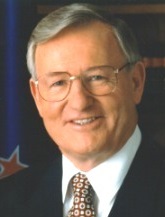 |
|
|
Premiership of Jim Bolger
|
|
|---|---|
| 2 November 1990 – 8 December 1997 | |
| Elizabeth II | |
| Cabinet | Fourth National Government of New Zealand |
| Party | New Zealand National Party |
| Election | 1990, 1993, 1996 |
| Appointer | Paul Reeves |
| Seat | Premier House |
|
← Mike Moore • Jenny Shipley →
|
|
Jim Bolger became Prime Minister on November 2, 1990. His government faced big challenges right away. One of the country's biggest banks, the Bank of New Zealand, needed to be saved from failing, which cost a lot of money.
First Term: Major Changes
To deal with money problems, Bolger's government, led by Finance Minister Ruth Richardson, made big cuts to government spending. This was known as the "Mother of All Budgets." Benefits for unemployed and sick people were reduced, and families received less support. People also had to start paying for some school and hospital services that used to be free.
Another major change was the Employment Contracts Act of 1991. This law changed the rules for workers and employers and led to a large drop in people joining unions.
During this time, Bolger's government also held a vote on changing New Zealand's voting system. In 1993, New Zealanders voted to switch from 'first past the post' to the Mixed Member Proportional (MMP) system, which is still used today.
Second Term: A Close Election
The 1993 election was very close. The National Party won by just one seat. This meant the government had to be very careful to keep its majority in Parliament.
During his second term, Bolger spoke in favour of New Zealand becoming a republic. This would mean having a New Zealander as the head of state instead of the British monarch. He also ended the practice of giving out British honours, creating a separate New Zealand Honours System.
In 1995, the Cave Creek disaster happened, where a viewing platform collapsed, killing 14 people. This led to criticism of the government and the Department of Conservation.
Third Term: Working with Another Party
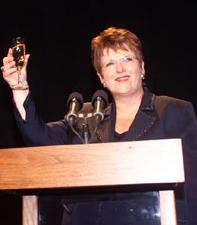
The 1996 election was the first under the new MMP system. No single party won enough votes to govern alone. The National Party, still the largest party, had to form a partnership, or coalition, with the New Zealand First party, led by Winston Peters.
As part of the deal, Peters became Deputy Prime Minister. Bolger's government continued its work, including settling historical land claims with Māori under the Treaty of Waitangi.
Resignation
By 1997, some members of the National Party were unhappy with Bolger's leadership. They felt he was giving too much power to New Zealand First. While Bolger was overseas, the Minister of Transport, Jenny Shipley, gathered enough support to challenge him.
Instead of facing a vote he would lose, Bolger resigned as Prime Minister on December 8, 1997. Jenny Shipley then became New Zealand's first female prime minister.
Life After Politics
Bolger left Parliament in 1998. He was then appointed as New Zealand's Ambassador to the United States, a role he held until 2001.
After returning to New Zealand, he took on several important roles in business. He became the chairman of New Zealand Post and its bank, Kiwibank. He was also chosen to be the chairman of KiwiRail when the government bought back the country's railway system. This was seen as ironic by some, because his government had sold the railways years earlier. Bolger said that "my life is full of ironies" and that the world had changed.
From 2007 to 2019, Bolger served as the Chancellor of the University of Waikato.
In recent years, Bolger has spoken out about the problems of poverty and inequality in New Zealand. He has said that the country needs to rethink how it runs its economy to make sure society is fair for everyone.
Honours and Personal Life

In 1998, Jim Bolger was appointed to the Order of New Zealand, the country's highest honour. His wife, Joan Bolger, was also honoured for her service to the community.
Jim and Joan Bolger have nine children. He is known for his calm and practical leadership style, which earned him the nickname "The Great Helmsman."
See also
 In Spanish: Jim Bolger para niños
In Spanish: Jim Bolger para niños
- Electoral history of Jim Bolger


